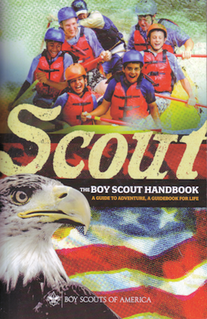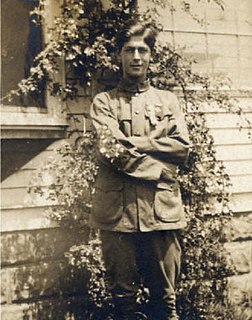
Eagle Scout is the highest achievement or rank attainable in the Scouts BSA program of the Boy Scouts of America (BSA). Since its inception in 1911, only four percent of Scouts have earned this rank after a lengthy review process. The Eagle Scout rank has been earned by over 2.5 million youth.
Advancement and recognition in the Boy Scouts of America is a tradition dating from the inception of the Scouting movement. A fundamental purpose of advancement is the self-confidence a young man or woman acquires from his participation in Scouting. Advancement is one of the methods used in the "Aims of Scouting"– character development, citizenship training and personal fitness.

Cub Scouting is part of the Scouting program of the Boy Scouts of America (BSA), available to boys and girls from kindergarten through fifth grade, or 5 to 10 years of age and their families. Its membership is the largest of the five main BSA divisions. Cub Scouting is part of the worldwide Scouting movement and aims to promote character development, citizenship training, personal fitness, and leadership.

Merit badges are awards earned by members of the Boy Scouts of America, based on activities within the area of study by completing a list of periodically updated requirements. The purpose of the merit badge program is to allow Scouts to examine subjects to determine if they would like to further pursue them as a career or vocation. Originally, the program also introduced Scouts to the life skills of contacting an adult they had not met before, arranging a meeting and then demonstrating their skills, similar to a job or college interview. Increasingly, though, merit badges are earned in a class setting at troop meetings and summer camps.

Scout Life is the monthly magazine of the Boy Scouts of America (BSA). Its target readers are boys and girls between the ages of 6 and 18. The magazine‘s headquarters are in Irving, Texas.

Sea Scouts is a program of the Boy Scouts of America for young men and women ages 14 through 20.

Varsity Scouting was a program of the Boy Scouts of America (BSA). It was an alternative available to boys ages fourteen to eighteen until the end of 2017. It used the basic Boy Scouting program and added high adventure, sporting, and other elements that were more appealing to older youth to accomplish the aims of character development, citizenship training, and personal fitness. Varsity Scouts were organized into teams; separate chartered units from a Boy Scout troop.

Boy Scout Handbook is the official handbook of Scouts BSA. It is a descendant of Baden-Powell's original handbook, Scouting for Boys, which has been the basis for Scout handbooks in many countries, with some variations to the text of the book depending on each country's codes and customs.
The uniform and insignia of the Boy Scouts of America (BSA) gives a Scout visibility and creates a level of identity within both the unit and the community. The uniform is used to promote equality while showing individual achievement. While all uniforms are similar in basic design, they do vary in color and detail to identify the different membership divisions of Cub Scouting, Scouts BSA and Venturing. Many people collect BSA insignia such as camporee and jamboree emblems, council shoulder strips and historical badges.

The National Eagle Scout Association is an organization of individuals who have earned the rank of Eagle Scout in the Boy Scouts of America. NESA's stated objective is "to serve Eagle Scouts and, through them, the entire movement of Scouting."
This is a list of merit badges formerly offered by the Boy Scouts of America. In some cases, the entire subject has been dropped from the merit badge roster. In others, the merit badge's name has been changed, with or without significant revision to the badge's requirements.
The history of merit badges in the Boy Scouts of America (BSA) has been tracked by categorizing them into a series of merit badge types. In addition to the Boy Scouts of America, many other Scouting and Scouting-like organizations around the world, such as Pathfinders, Baden-Powell Scouts and Royal Rangers, issue merit badges or their equivalent; though they are sometimes called honors or proficiency badges. Other organizations, such as fire brigades, issue badges or awards that they refer to as merit badges, but that is in some respects different from the badges awarded by the BSA.

Arthur Rose Eldred was an American agricultural and railroad industry executive, civic leader, and the first Eagle Scout in the Boy Scouts of America (BSA). As a 16-year-old candidate for the highest rank bestowed by the BSA, he was personally interviewed by a panel composed of the youth organization's founders, including Ernest Thompson Seton and Daniel Carter Beard. Eldred was awarded the coveted distinction of Eagle Scout on September 2, 1912, becoming the first of more than two million boys in the U.S. since then to earn Scouting's most vaunted rank. Eldred also received the Bronze Honor Medal for lifesaving, and was the first of four generations of Eagle Scouts in his family.

Scouts BSA is the flagship membership level of the Boy Scouts of America (BSA) for boys and girls between the ages of typically 11 and 17. It provides youth training in character, citizenship, and mental and personal fitness. Scouts are expected to develop personal religious values, learn the principles of American heritage and government, and acquire skills to become successful adults.

First Class Scout is a rank in the Boy Scouts of America, the rank above Second Class and below Star Scout. It is the highest of the lower four ranks in Scouting, and is the minimum rank that need be attained for entry into the Order of the Arrow.

The World Conservation Award is issued by many of the national Scout associations affiliated to the World Organization of the Scout Movement, and was created in conjunction with the World Wide Fund for Nature, partially in response to the rise in popularity of Green Scouting, at some time prior to 1977. Different countries have set different standards or criteria in order for Scouts to receive this award.

The Boy Scouts of America (BSA) was inspired by and modeled on The Boy Scouts Association, established by Robert Baden-Powell in Britain in 1910. In the early 1900s, several youth organizations were active, and many became part of the BSA.

The advancement program for Scouts participating in the Scouts BSA program of the Boy Scouts of America is symbolized by the earning of seven ranks. The advancement program is often considered to be divided into two phases. The first phase from joining to First Class is designed to teach the scout Scoutcraft skills, how to participate in a group and to learn self-reliance. The Scout badge is awarded when the Scout demonstrates a rudimentary knowledge of the Scouting ideals and program. Tenderfoot, Second Class, and First Class have progressively harder requirements in the areas of Scoutcraft, physical fitness, citizenship, personal growth and Scout Spirit.

Square knot insignia are embroidered cloth patches that represent awards of the Scout associations throughout the world.
The Boy Scouts of America was incorporated on February 8, 1910 and celebrated its centennial from September 1, 2009 through December 31, 2010.














